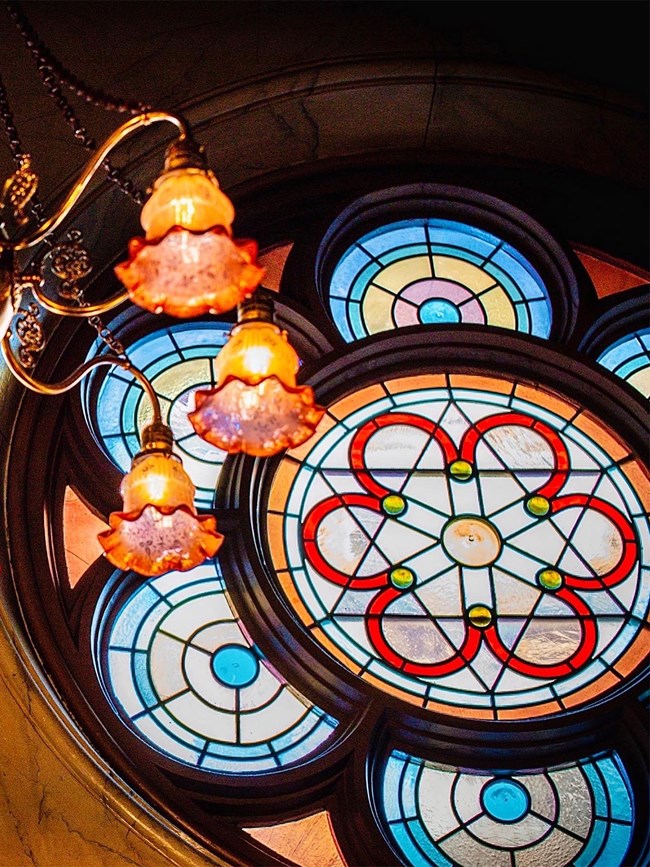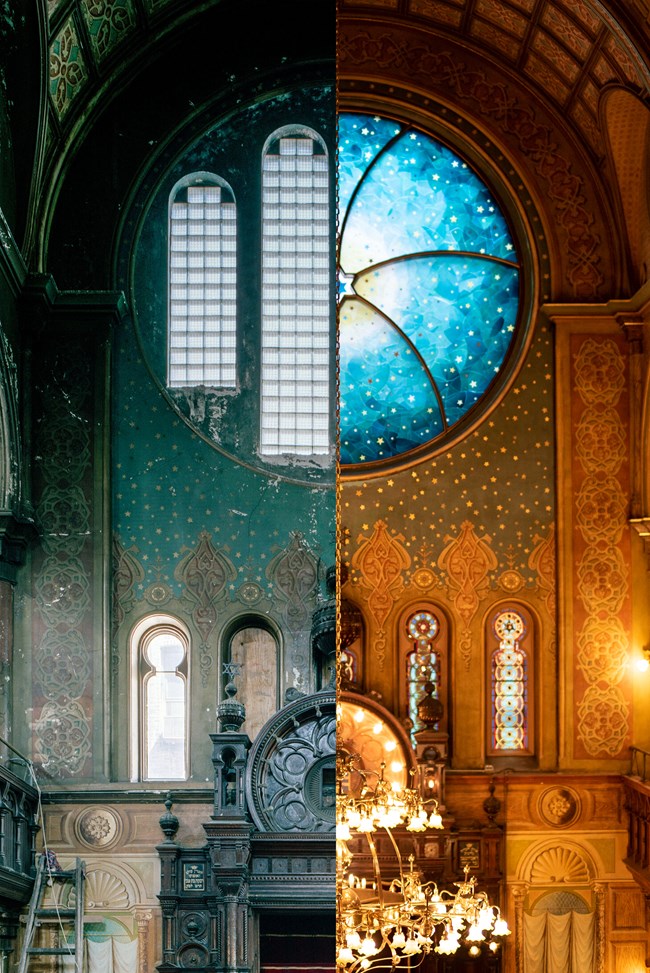Part of a series of articles titled National Register and National Historic Landmarks Celebrate Jewish Heritage Month.
Article
Eldridge Street Synagogue in New York’s Lower East Side

Michael Lee. Courtesy of the Museum at Eldridge Street.
Orthodox Jewish Immigration to New York City
In the mid-nineteenth century, a small community of Orthodox Jews—mostly from Russia—lived in New York City’s Lower East Side. Many worshipped in small congregations with others from their hometown or region. However, the Beth Hamedrash congregation, which formed in 1852, included people from many different countries. Although they were all Orthodox Jews, different groups within the congregation had different customs and practices. One point of disagreement was the balance between religious and lay authority. In 1859, Beth Hamedrash split over this issue. One group followed Rabbi Joseph Abraham Ash and took the name Beth Hamedrash Hagodol. The group that followed the lay leadership later became Congregation Kahal Adath Jeshurun.Kahal Adath Jeshurun grew rapidly in the 1880s as a result of a wave of Jewish immigration from Eastern Europe to New York City. During this period, millions of Jews fled to the United States from Russia and Eastern Europe to escape widespread persecution and violent attacks known as pogroms. While some moved to other parts of the country after arriving in New York City, most Orthodox Jewish immigrants remained in the city and settled in the Lower East Side neighborhood of Manhattan.

National Historic Landmark Nomination photograph by Fernando Joffroy, Public Art Fund, Inc.
A New Building for a Growing Community
By the mid-1880s, the congregation was outgrowing its existing synagogue. Kahal Adath Jeshurun had merged with another Lower East Side congregation (Holkhe Yosher Vizaner), and new immigrants were joining the congregation. The congregation had another reason to move as well: the city planned to construct an elevated rail line right next to their synagogue.Completed in September 1887, the synagogue on Eldridge Street was one of the first grand synagogues built by Eastern European Orthodox Jews in the United States. The large and opulent house of worship made a powerful statement about the vibrancy and growth of Orthodox Judaism on the Lower East Side. The synagogue became a central institution in the neighborhood and in the city’s Orthodox communities. In 1896, representatives of Orthodox congregations met in Eldridge Street Synagogue to create a nationwide organization that two years later would become the Union of Orthodox Jewish Congregations.

Erin Flynn. Courtesy of Museum at Eldridge Street.
Congregational Decline
In 1909, Congregation Anshe Lubz joined Kahal Adath Jeshurun. Two years later, Eastern European Jewish immigration to the United States reached its peak. Immigration from Europe continued to decline after the outbreak of World War I in 1914. In 1924, Congress passed the Johnson-Reed Immigration Act, which set quotas for immigrants based on their country of origin. The act severely limited the number of Jewish immigrants moving to the United States and into the Lower East Side neighborhood. In the early twentieth century, Jewish residents also began to move out of the Lower East Side, into neighborhoods in Harlem, the Bronx, and Brooklyn.As the Orthodox Jewish population in the Lower East Side declined, so too did membership in Congregation Kahal Adath Jeshurun with Anshe Lubz. In the 1930s, they held regular services in the study room (bes medresh) in the basement and only used the main sanctuary for special services. By the mid-1950s, the main sanctuary was sealed shut.

Courtesy of Museum at Eldridge Street.
Preservation
Opening the doors to the historic sanctuary in the early 1970s revealed finely crafted woodwork and plasterwork, including a wood ark, domed ceilings, and an elaborate chandelier. Although the interior was intact, it was damaged and endangered by water and insects. Grassroots preservation efforts led to the formation of the non-profit Eldridge Street Project in 1986. Led by Roberta Brandes Gratz, the organization raised funds and oversaw a complete restoration of the interior and exterior. In support of the preservation efforts, Eldridge Street Synagogue was listed in the National Register of Historic Places on March 29, 1980, and designated a National Historic Landmark on June 19, 1996.The restoration was completed in 2007. The Museum at Eldridge Street is open to the public and interprets the history of the Lower East Side and synagogues. The museum offers tours of the building and neighborhood, exhibitions, and a variety of cultural programs.
Further Reading
Gurock, Jeffrey S. “A Stage in the Emergence of the Americanized Synagogue among East European Jews: 1890–1910.” Journal of American Ethnic History 9:2 (Spring 1990): 7–25.Newman, Renee, Maria Schlanger, and Amy E. Waterman. Eldridge Street Synagogue, New York, New York. National Historic Landmark Nomination, 1995.
Polland, Annie. Landmark of the Spirit: The Eldridge Street Synagogue. New Haven: Yale University Press, 2009.
Wolfe, Gerard R., Jo Renee Fine, and Norman Borden. The Synagogues of New York's Lower East Side: A Retrospective and Contemporary View. 2nd Edition. New York: Fordham University Press, 2012. See especially Introduction and Chapter 1.
Last updated: May 23, 2024
